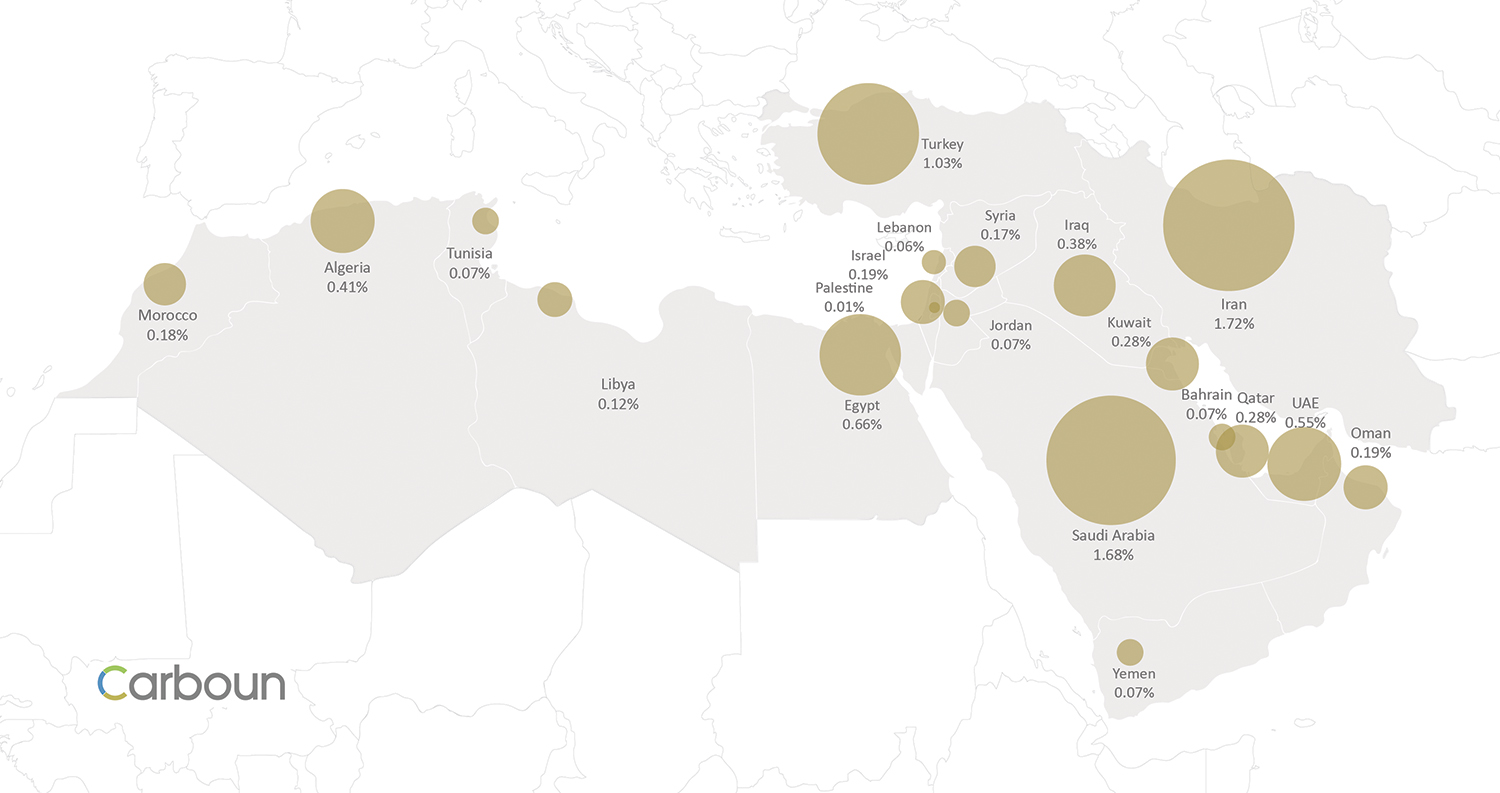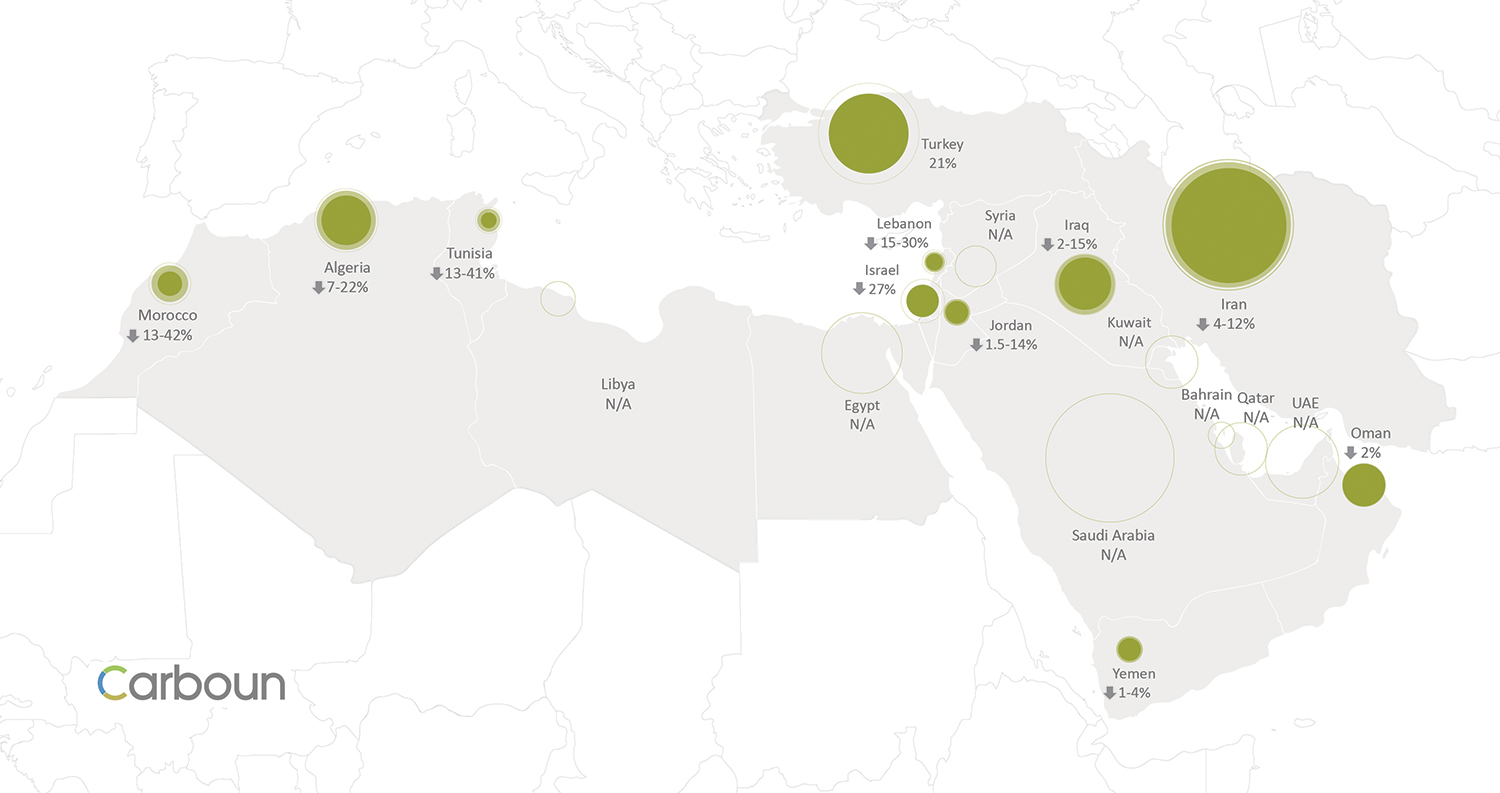
National share of 2014 global carbon emissions across the Middle East and North Africa region, including Turkey, Iran, and Israel. Copyrights: Carboun
Karim Elgendy
The two-week COP 21 climate conference in paris (also known as the 21st Conference of Parties to the United National Framework Convention for Climate Change ) ended on Saturday 12 December with an adopted agreement covering 195 countries, and providing a framework for voluntary efforts to significantly reduce carbon emissions starting 2020.
The Paris Agreement and its Structural Challenges
The agreement – which remains subject to ratifications and approvals by invidiual countries, and is pending a formal signing process commencing April 2016 – was widely celebrated as a long awaited step forward in global climate action. Its most widely cited outcome was that parties to the agreement collectively committed themselves to a reduction to carbon emissions that would keep global warming below the limits of what climate scientists consider as ‘dangerous climate change’. Not only did they agree to collectively limit global warming ‘well below’ 2 degrees celsius (above pre-industrial levels), but the agreement also referred to an aspiration to limit global warming to 1.5 degrees, in the interest of protecting the low-lying island from sea level rise, to which they are most vulnerable.
From a national standpoint, however, the collective commitment remains a voluntary one. With the failure of the Copenhagen COP 15 in mind, the COP 21 negotiators steered away from dictating how much individual countries should cut their carbon emissions by or how they should do it, and left this to national governments to determine. This unusual approach was partly a result of the failure of negotiations over the last two decades to resolve the ‘differentiation’ of climate responsibilities between developing and developed countries, in light of their different positions on the development curve and their different shares of historical emissions.
According to this voluntary approach, individual countries were only required to submit an emission reduction pledge – also known as an Intended Nationally Determined Contributions (INDC). The obvious downside to this approach is that collective emissions reduction pledges by all countries may not necessarily meet the emissions reduction targets of the agreement, represented in the form of 1.5 to 2 degrees global warming. In fact, when added up, the emissions reductions from all 187 INDCs submitted ahead of the COP were calculated to lead to a global warming of 2.7 degrees, a much worse trajectory in the non-linear world of climate change science, and well into the ‘dangerous climate change’ territory.
Mechanisms and Assumed Developments
To address its structural challenges and the climate shortfall, the agreement relies on two mechanisms that attempt to bridge this ‘emissions gap’, without dictating targets upon each nation. The first of these mechanisms is using positive peer and reputational pressure to encourage countries to match or exceed emission reductions by others. Given the disparity of climate actions around the world to date, the reliability of such mechanism is questionable without a critical mass of pioneering nations. Yet the positive energy surrounding the agreement has the potential to create momentum and positive peer pressure.
Another critical mechanism is the so-called ‘ratcheting mechanism’ – a 5-yearly process of reconfirming or increasing national climate commitments – starting 2025. In principle, this mechanism is commendable. Yet most climate road maps suggest that emissions need to peak by 2020. Ratcheting pledges 5 years after that date might thus prove too little too late. To address this shortfall, efforts are already underway to update pledges as early as 2020, with a ‘facilitative dialogue’ scheduled for 2018.
In addition to these mechanisms, the agreement also relies on assumed future developments that could take place as a result of the accord. One assumption is is that in order to gain competitive advantage, industries and investors would be inclined to decarbonise and steer future technology away from fossil fuels and towards cleaner energy sources. Another assumption is that governments would be inclined to align their national policies with their commitments at Paris, including removing fossil fuel subsidies and investing in renewable energy research and development.
The Role of the Middle East and North Africa Region
MENA countries including North African, Levantine, GCC Arab countries are all parties to the Paris agreement, including Palestine which became a member of the UNFCCC during the COP 21 . Non-Arab Middle Eastern countries Iran, Israel, and (increasingly Middle Eastern) Turkey are all parties to the agreement as well.
For major oil and gas exporters of the Middle East, the impact of this agreement cannot be overstated. To reduce carbon emissions to a limit that ensures global warming of 1.5 to 2 degrees, emissions will have to peak by 2020 and to rapidly decline throughout the twenty first century. The world’s economies and their energy sources would need to undergo a radical transformation away from fossil fuels to achieve this target. Not only will new electricity capacity have to come from renewable (and nuclear) energy sources, but existing fossil fuel based energy sources will need to be replaced too. Major oil and (to a lesser degree) gas exporters might find themselves with stranded assets in the form of fossil fuels that no one is eager to buy. They might also find themselves under pressure to accelerate their efforts to diversify their economies away from hydrocarbons.
It is thus unsurprising that some Middle Eastern oil exporters negotiated hard to preserve their interests. An Arab bloc led by Saudi Arabia is reported to have objected to the 1.5 degree limit to global warming. Saudi Arabia was also reported to have objected to the ‘ratcheting mechanism’ on the basis of the bureaucratic burden it creates, and to have been opposed to the notion of decarbonisation. Naturally, such positions have earned Saudi Arabia the scorn of climate NGOs, one of whom has awarded the kingdom the “Fossil of the Day Award” three times during the negotiations. By comparison, Egypt, a net energy importer and a particularly vulnerable economy to climate change and sea level rise, publicly called for a 1.5 degree limit to global warming in its opening speech.
Regional Climate Pledges

National pledges to reduce carbon emissions across the Middle East and North Africa region, including Turkey, Iran, and Israel (compared to 2030 BAU scenario). Copyrights: Carboun
In terms of climate pledges, While most regional countries submitted an INDC – with the exception of Syria, Libya, and palestine – pledges varied widely in their ambitions and their conditionality on financial support. The most progressive pledges came from North Africa. Morocco announced it was committed to a reduction of 42% of carbon emissions by 2030 (compared to a ‘2030 business as usual’ scenario) if it receives financial support (with 13% of this reduction being unconditional). It aims to achieve this by generating 42% of its energy from renewable sources (including hydro electricity) by 2020 and 52% by 2030. It also vowed to cut its energy subsidies, which are low by regional standards. At a close second comes Tunisia, which pledged 41% reduction of emissions if it receives financial support (13% of which is unconditional).
These regional pioneers are followed by a group of Levantine and North African nations including Lebanon’s 30% conditional pledge (15% of which are unconditional), Algeria’s 22% (7% unconditional), Iraq’s 15% by 2035 (2% unconditional), and Jordan’s 14% (1.5% unconditional). The only exception to this was Egypt, which surprisingly did not make a quantifiable commitment despite its progressive position on limiting global warming to 1.5 degrees.
Yet, while some of these emission reduction pledges are certainly ambitious (compared to those made by the United States and Australia, for example), but the fact that they hinge on future financial support significantly undermines them. And while $100 billion of financial support was committed to in a legally binding section of the Paris agreement, the conditional nature of these pledges makes them less credible than unconditional commitments by more economically developed regional countries such as Israel (26% emissions cut) and Turkey (21% emissions cut).
Disappointingly, GCC countries have generally avoided committing to an actual emissions reduction figure in their INDCs, with the exception of Oman, which committed to 2% unconditional reduction in carbon emissions. While such position may be understandable given the economic risks at stake, the lack of concrete pledges should also be seen in light of the GCC economies need for diversification and decarbonization, as well as the GCC’s own climate change risks. For example, in one climate scenario, sea level rise threatens populated areas of Dubai, Abu Dhabi, Doha, and Manama with inundation. Another risk facing the coastal areas around the gulf according to one climate scenario is a dangerous rise in wet bulb temperatures rendering them unfit for human habitation by 2070.
The UAE – which appears hard at work re-positioning itself as the GCC leader on climate issues- provided the gulf region’s only concrete pledge in the form of energy diversification away from fossil fuels. It announced an impressive commitment to generate 24% of its energy coming from ‘clean’ sources by 2021 (the year of the union’s golden jubilee), and appears to be on target for a federal energy mix that includes 7% from renewable sources, with the remaining 17% sourced from 4 nuclear power stations currently under construction in Abu Dhabi.
On the other side of the Arabian peninsula, Yemen – despite its ongoing civil war – somehow managed to submit a pledge of 14% conditional emission reductions (only 1% of which was unconditional). Across the gulf, Iran – the largest emitter of carbon across the region at 1.74% of global emissions – committed to a 12% reduction of carbon emissions if it receives financial support (with 4% of these being unconditional).
Regional Responsibility
The region’s share of carbon emissions cannot be dismissed. If Iran, Turkey, and Israel are included, the Middle East and North Africa region would account for more than 8% of global carbon emissions (according to 2014 data by Global Carbon). Iran and Saudi Arabia are the world’s 8th and 9th highest carbon emitters respectively, Surpassing industrialized countries such as the UK, France, Italy, and Canada. Yet, the region’s commitment to reducing its carbon emissions does not seem to be in line with its share of responsibility, nor does it reflect its own vulnerability to climate change.
With the next COP scheduled for Marrakesh in 2016, the global attention is expected to shift once more to the role of the region. This would come at a time when efforts are expected to focus on closing the ‘emissions gap’ and discussing updating INDCs ahead of the 2018 ‘facilitative dialogue’. In this context, relatively weak, highly conditional, or ambiguous climate pledges from across the middle East and North Africa would come under increased scrutiny.
Yet countries of the region needn’t see this process as a risk, but rather as an opportunity. The Paris agreement has created a framework for efforts to limit climate change. The targets and road map created by the agreement are set to create a new normal for the global economy, more sustainable energy systems, and a safer world for the the regions most vulnerable to climate change. Regional decision makers are advised to leverage this moment of transition to transform and diversify their economies away from hydrocarbons, and to seize the opportunity of global goodwill -including the pledges of technical and financial support- to jump start this process.
Karim Elgendy is a sustainability consultant and architect based in London. He can be contacted at: Karim [at] Carboun [dot] com .
